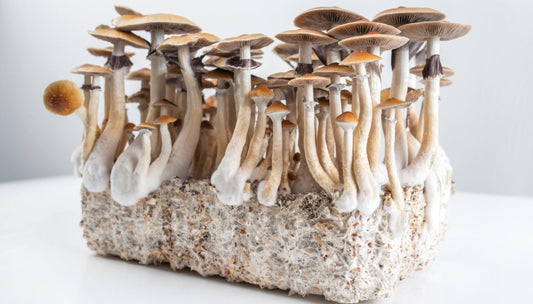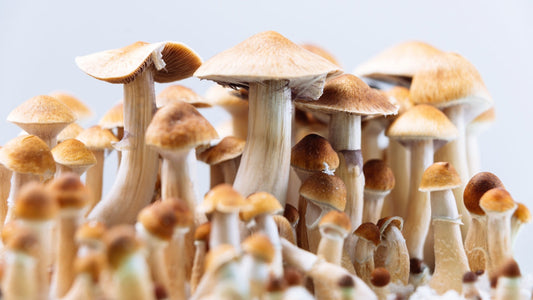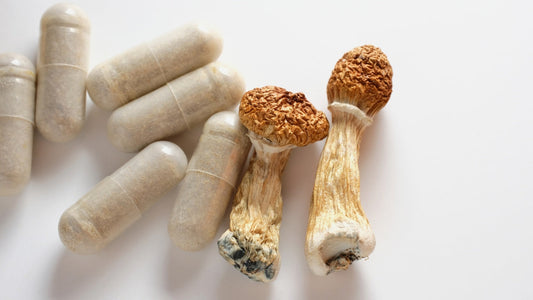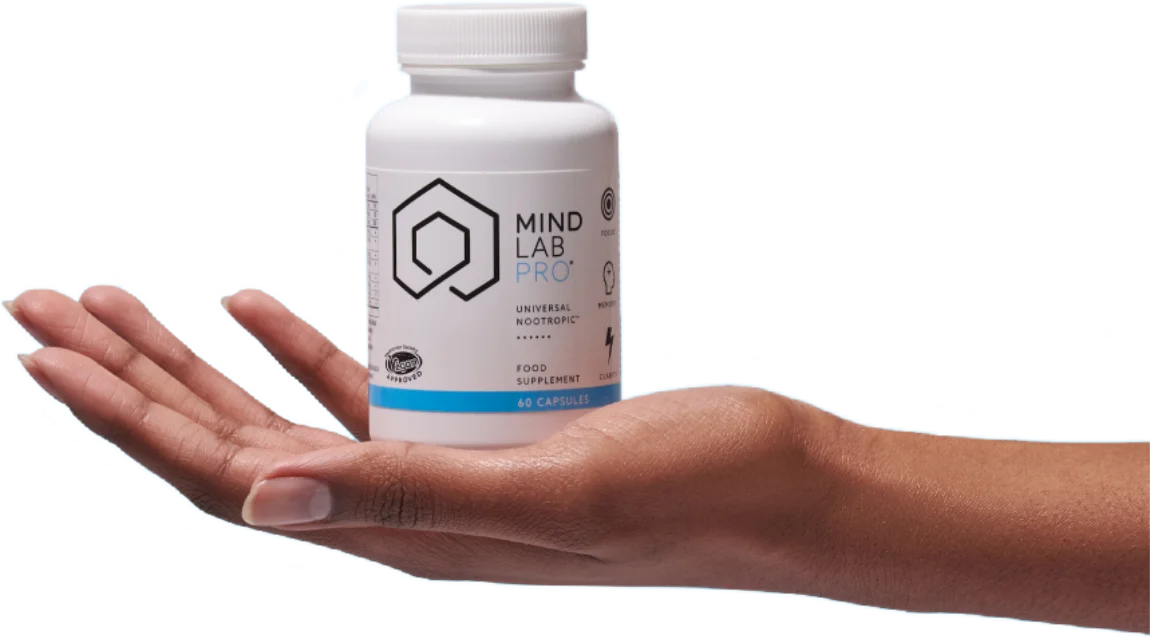Microdosing typically means taking a small, sub-perceptual amount of a psychedelic mushroom (most often Psilocybe) on a structured schedule to nudge mood, focus, and creativity without tripping. While many users report benefits, high-quality clinical evidence is still limited, effects vary widely, and legality/safety must come first.
In this overview, we detail how the practice of microdosing came to prominence, cover some of the research supporting microdosing, and provide information on some of the more widely accepted microdosing protocols. Let's get to it!
Key Takeaways
- A “microdose” is a very low dose of dried psilocybin mushroom designed to be sub-perceptual -- no visuals, altered states or impairment.
- Popular microdose protocols include the Fadiman (1 day on, 2 off) and Stamets (4 on, 3 off) approaches; both build in “off” days to limit tolerance.
- A hallucinogenic dose of psilocybin is about 3-5 g dried mushroom. Microdoses are about 1/10th of that, so .3 to .5 g. People usually start at the low end and then increase in small increments.
- Microdoses may be best taken on predictable, low-stress mornings; logging mood, focus, sleep, anxiety, and side effects to evaluate how the protocol is working.
- Some users report improved mood, reduced anxiety, better focus/creativity, and ease with habits -- results are mixed and not guaranteed.
- Side effects may include anxiety, jitteriness, GI upset, distraction, or sleep changes; higher doses can become noticeably psychoactive.
- Like other psychedelic drugs, Psilocybin remains illegal in many places; know local laws and never travel or share across jurisdictions.
Disclaimer
The information in this article is provided for educational purposes only and is not medical, legal, or professional advice. Psilocybin-containing mushrooms are illegal in many jurisdictions; always know and follow your local laws.
- Do not use this content to diagnose, treat, cure, or prevent any disease. Consult a licensed healthcare professional before starting, stopping, or changing any regimen.
- Avoid microdosing if you have a history (personal or family) of psychosis, schizophrenia, or mania/hypomania (including bipolar disorder), or if you are pregnant or nursing.
- Psychedelics can interact with prescription and over-the-counter drugs (e.g., SSRIs/SNRIs, MAOIs, stimulants). Discuss risks with your clinician; never change medications without supervision.
- Effects can be unpredictable. Do not drive, operate machinery, or engage in risky activities if you feel impaired or altered.
- This article does not encourage illegal use. If someone chooses to proceed where lawful, accurate dosing, careful set/setting, and symptom tracking may reduce (not eliminate) risks.
- Potency varies by species, batch, and preparation; wild foraging carries misidentification and contamination risks.
- Claims about benefits are based on preliminary or mixed research; individual responses vary and benefits are not guaranteed.
Psilocybin Mushrooms: What They Are

Psilocybin mushrooms are a group of fungi -- most commonly in the genus Psilocybe (e.g., P. cubensis, P. mexicana, P. semilanceata) and, less often, related genera like Panaeolus and Gymnopilus -- that contain the psychoactive compounds psilocybin and psilocin.
After ingestion, psilocybin converts to psilocin, which interacts primarily with serotonin receptors to produce changes in perception, mood, and cognition. These effects depend heavily on dose, mindset (“set”), and environment (“setting”).
Traditional Uses and History
- Pre-Columbian Mesoamerica: Indigenous peoples of what is now Mexico and Central America used sacred mushrooms -- called teonanácatl (“flesh of the gods”) in Nahuatl -- in divination, healing, and spiritual rites.
- Colonial suppression: Following Spanish conquest, ceremonial use was pushed underground, but lineages of practice persisted in rural and Indigenous communities.
- Modern rediscovery (1950s): Ethnomycologist R. Gordon Wasson’s accounts of Mazatec ceremonies (notably with María Sabina, a curandera or female folk healer) brought global attention; soon after, chemist Albert Hofmann (lysergic acid diethylamide [LSD] pioneer) isolated and identified psilocybin/psilocin (1958).
- 1960s research and prohibition: Early clinical exploration of psychedelics stalled amid social/political backlash and criminalization, stopping most human studies for decades.
- Contemporary renaissance: Since the 2000s, carefully regulated trials have resumed at major universities, investigating psilocybin for depression, anxiety, end-of-life distress, and substance use disorders -- while public interest in careful, low-dose “microdosing” has grown.
The Rise of Microdosing Psilocybin
Educational only, not advice: Microdosing refers to taking a sub-perceptual amount of a psilocybin-containing mushroom. A microdose can be as low as five to ten percent of a typical "recreational" dose. Microdosing has drawn interest for its potential to help with a wide range of mental health concerns, including anxiety, depression, and OCD (obsessive-compulsive disorder).(1)
While so-called "magic mushrooms" can produce intense psychedelic experiences, the microdose works more subtly: any psychedelic sensations are typically mild or not even noticeable.
The psilocybin microdose is taken on a repeating schedule -- ranging from 1-4 doses per week for 2-6 weeks -- to nudge mood, focus, and creativity without producing a full psychedelic experience. We'll get more into these schedules in a moment.
There's a lot of buzz surrounding psilocybin for brain health. But it's important to remember that despite the growing body of anecdotal reports suggesting benefits, real scientific research is early; preliminary at best.
A Note on Dosing vs Microdosing
dried mushroom is one measure; another is extracted psilocybin. We're talking the latter in this article. It's important to remember. Microgram scale is advisable. Levels vary among strains and species.
How Microdosing Came to Prominence
The modern microdosing wave took off in the 2010s at the intersection of tech, wellness, nootropic and biohacking movements. Psychologist James Fadiman popularized a structured “one day on, two days off” rhythm and invited large-scale self-reports. Mycologist Paul Stamets amplified interest with his stacking concept. Online communities helped to further mainstreamed the practice.
Who’s Interested, and Why
People interested in microdosing range from students to professionals to older adults. Common goals include improved mood and anxiety relief, greater focus and creativity, support for habit change, and general well-being. Reports are highly individual and not guaranteed.
Brief Research Summaries
Some prospective cohort studies note small improvements in mood/well-being over weeks; “stacking” practices are common in the wild but remain unverified clinically. Placebo-controlled studies suggest that low-dose psilocybin can produce noticeable short-term effects, but consistent advantages over placebo on cognition/creativity or well-being are not yet backed by strong evidence.
Some quick microdosing research summaries:
- Using 0.5 g dried Psilocybe cubensis twice per week, participants showed clear acute subjective effects and EEG theta reductions, but no improvements in creativity, cognition, well-being, or activity versus placebo (with a few small signals toward cognitive impairment on tasks).(2)
- The largest placebo-controlled microdosing study found both microdose and placebo groups improved on psychological outcomes, with no significant differences between them -- implicating placebo effects as a major driver of perceived benefits.(3)
- In 953 microdosers vs 180 controls over about1 month, microdosers reported greater improvements in mood/mental health and older adults showed better psychomotor (finger-tap) performance; “stacking” with lion’s mane/niacin did not change mood outcomes overall (non-randomized, not blinded).(4)
- Among 98 microdosers, ratings of psychological functioning were higher on dose days with some longer-term shifts (lower depression/stress, reduced distractibility), alongside signs of placebo effects and mixed outcomes -- highlighting the need for controlled trials.(5)
Keep in mind these are not Gold Standard quality studies (double blind, placebo-controlled, randomized, etc). Psilocybin research is ongoing; most use today is rooted in traditional practices and anecdotal reports of mental and spiritual benefits.
What does Microdosing Feel Like (vs. Regular Dosing)

Microdosing psilocybin is best described as a nudge, not a trip. On a true microdose, most people feel essentially normal -- able to work, study, and hold conversations -- while noticing a faint lift in mood, a touch more ease starting tasks, or a slightly brighter, more curious outlook. If anything perceptual changes at all, it’s subtle: colors can seem a shade richer, music a bit more interesting, and attention a little sharper.
With microdosing, onset typically arrives 30-90 minutes after dosing, with a gentle plateau for a few hours before tapering to baseline by late day. Because the goal is sub-perceptual, any obvious intoxication (waviness in vision, impaired focus, or pronounced euphoria/anxiety) is a sign the dose is too high for microdosing.
Responses vary -- some people feel nothing; others report light jitteriness, queasiness, or sleep disruption -- so precise weighing, small adjustments, and simple daily notes (mood, focus, sleep, anxiety) help determine whether there’s a real benefit or just expectation.
A standard or “regular” psilocybin dose is different: it is an altered state that arrives in waves and often reshapes perception, emotion, and meaning for several hours. The experience usually peaks around the 2-3 hour mark and can include time dilation, vivid sensory enhancement, intricate visual patterning (eyes open or closed), intensified music/emotion, and at higher doses, “ego-dissolving” experiences. Cognition turns inward; routine tasks, small talk, and decision-heavy work become difficult or ill-advised.
Body sensations can feel amplified (lightness, warmth, tingling) and nausea is common near onset. The whole experience often lasts 6–8+ hours, followed by an “afterglow” that can linger into the next day.
Set (mindset) and setting (environment) heavily shape whether the journey feels expansive and therapeutic or anxious and challenging; skilled preparation and integration matter.
Side-by-side, microdosing is about consistency and calibration; regular dosing is about depth and transformation.
Microdosing aims for gentle steadiness. Tiny, repeatable doses spaced with off-days to minimize tolerance, maintain functionality, and test whether subtle improvements in mood, focus, or habit change are real. True microdosing should not impair driving or complex work (however always take caution); if you feel altered, the dose is technically not a microdose, because microdoses are supposed to be sub-perceptual.
A regular psilocybin dose is a bigger event. It is more like a psychological journey. It typically requires scheduling, a safe place, and often a sober sitter or guide; afterward, people commonly journal, reflect, or integrate insights. A "normal" dose can involve big emotions and may be challenging for some people.
Neither approach is one-size-fits-all: individuals differ widely in sensitivity, mental-health background, and goals.
How to Microdose Mushrooms

Note: Doses below are typically expressed as dried Psilocybe cubensis mushrooms. Potency varies by species, strain, and batch; gram amounts are not equivalent across materials. The following protocols are intended for educational use only and should not be taken as guidance.
The Fadiman Protocol
The Fadiman approach typically uses a sub-perceptual dose of about 0.05–0.3g dried Psilocybe (potency varies by batch/species). The schedule is one day on, two days off, repeated for several weeks before taking a longer break.
This protocol emphasizes careful self-observation -- keeping a brief journal of mood, focus, energy, sleep, and side effects -- to identify the minimal effective dose that remains non-disruptive to daily life.
Who is James Fadiman? James Fadiman, PhD, is an American psychologist and author best known today for popularizing microdosing. He co-founded the Institute of Transpersonal Psychology (now Sofia University), has been involved in psychedelic substances research since the 1960s, and is widely considered a pioneer of psychedelic science and a key advocate of LSD and magic mushrooms. Fadiman participated in early Menlo Park problem-solving studies exploring psychedelics and creativity.
More on The Menlo Park Study
In The Menlo Park pilot study of 1966, researchers gave 27 male professionals a single, carefully prepared session with LSD or mescaline and had them work on their own “stuck” technical/creative problems. Under these conditions, the authors reported improved creative problem-solving during the session (better pattern recognition/visualization on tests and devising viable creative solutions), with some participants carrying solutions forward into their work and self-reported gains persisting for weeks. Researchers stressed the findings were tentative (no control group; research stopped soon after).(6)
How microdosing entered the mainstream via Fadiman. Decades later, in 2011 Fadiman published The Psychedelic Explorer’s Guide, which introduced the idea of taking very small, “sub-perceptual” doses of psychedelics for day-to-day functioning. In the mid-2010s he began circulating simple instruction sheets and "crowd-sourced" data -- collecting thousands of participant reports, helping move microdosing from niche forums into wider public awareness.
What he proposed (the protocol). The pattern most associated with Fadiman is one day on, two days off. So dose on Day 1, no dose on Days 2-3, then repeat. His rationale: keep doses low enough to avoid any altered consciousness, build in “off” days to limit tolerance, and pair the practice with journaling so users can detect whether the routine is helping or not. In parallel scientific and media summaries, typical psilocybin “microdose” amounts are described in the neighborhood of about 0.1–0.5 g dried, with the protocol itself often framed as dosing “every third day.”
After decades of high- and moderate-dose research limitations, Fadiman sought a low-risk, everyday protocol that anyone could try while contributing structured, citizen-science observations. He began gathering these reports around the early 2010s and formalized an initial analysis (with Sophia Korb) in 2019, describing an “every three days” protocol and summarizing outcomes self-reported by about 1,000 participants across 59 countries. Their findings:(7)
- Frequently reported reduced negative mood (especially depression) and increased positive mood.
- Described more energy, greater work effectiveness, and healthier habits.
- In smaller subsets, noted symptom relief for issues such as migraines, PMS, traumatic brain injury, and shingles.
Fadiman and Korb emphasized the weak nature of the data collected and called for controlled clinical trials, noting more robust evidence is needed to further evaluate safety and efficacy.
Fadiman’s reports (and later academic overviews) emphasize that microdoses are a fraction of a standard psychedelic dose and should remain below the threshold of noticeable mind-state alteration. The “two days off” were intended to minimize tolerance -- an effect well-documented with classic psychedelics -- and to keep daily functioning intact.
Journalistic profiles have traced Fadiman’s interest in low-dose regimens to conversations about Albert Hofmann’s speculation on the potential of small LSD doses, and they credit him with catalyzing the 2010s microdosing “wave” alongside tech and wellness subcultures that amplified his protocol. (These are reported anecdotes rather than controlled findings.)
Where things stand now. Fadiman’s schedule and language are cited across reviews and trials: many papers note the 0.1-0.5 g dried psilocybin range and the every-third-day pacing popularized by his work. Subsequent placebo-controlled studies have found strong placebo effects and mixed advantages over placebo on cognition or well-being, underscoring that the protocol is historically influential but not yet clinically validated.
Notes: This profile is descriptive, not guidance. Potency varies widely by species and batch; legal status also varies by jurisdiction.
The Stamets Stack
The Stamets concept stacks a psilocybin microdose (often about 0.10–0.30 g dried mushroom) with non-psychedelic ingredients such as lion’s mane and niacin. A commonly referenced pace is four days on, three days off, often run in 4–6-week blocks followed by a washout period.
While widely discussed in community practice, the combined “stack” remains lightly studied in controlled clinical settings; users still rely on symptom tracking and conservative dosing.
Who is Paul Stamets? Paul Stamets is a U.S. mycologist, author of Mycelium Running (2005), and a prominent advocate for the ecological and health applications of fungi. He has lectured widely and holds multiple patents related to mushroom-based formulations.
Let's now dig into the “Stamets Stack.”
Psilocybin + Lion’s Mane + Niacin (“Stamets Stack”)
The stack refers to combining a psilocybin microdose with lion’s mane (Hericium erinaceus) and niacin (vitamin B3, nicotinic acid). In his patents, Stamets proposes these ingredients are included for their potential neuroregenerative and neuroplastic effects, arguing that lion’s mane compounds (erinacines/hericenones) support Nerve Growth Factor (NGF) pathways and that niacin may help with distribution of psychoactive compounds to peripheral nerves. Let's take a closer look at how these ingredients may complement psilocybin.
Lion’s mane mushroom

This pale, shaggy mushroom supplies active compounds like hericenones and erinacines shown to stimulate nerve growth factor-related pathways. In theory, lion's mane may support nerve regeneration and brain plasticity in ways that complement psilocybin's plasticity potential. Using more than one nutrient to optimize the same brain pathway is a classic nootropic stacking technique.
Lion's mane is the best nootropic mushroom out there for supporting mood and cognitive function. There is no evidence suggesting it changes the positive effects of psilocybin, although anecdotally some people report a "smoother" psilocybin experience when paired with lion's mane.
Discover the top 7 benefits of Lion's Mane Mushroom
Niacin (Vitamin B3 or nicotinic acid)

In the Stamets stack, niacin (nicotinic acid) isn’t psychedelic and isn’t meant to intensify psilocybin’s effects. It’s instead included to produce a peripheral “flush” (vasodilation) which theoretically may help with distributing co-ingested supplements to the brain (and throughout the body). Because the "flush" is a desired effect in this stack, do not take "no-flush" forms of niacin; plain vitamin B3 will do.
In anecdotal reports, some people have also said they use the niacin flush as a clear “on” signal during microdosing; it helps them note that the microdose is taking effect. There’s no solid human evidence that niacin boosts the psychedelic experience or adds clinical benefit to psilocybin.
Paul Stamets has described a stack that uses about 500 mg of lion’s mane (mycelium) and 50 mg of flushing niacin (vitamin B3, nicotinic acid) per microdose. He clarifies this is his personal regimen and that individual results may vary.
How people say it’s done (community practice). In popular guides, a commonly referenced rhythm is 4 days on, 3 days off, with a psilocybin microdose roughly in the 0.10–0.30 g dried range, paired with lion’s mane and low-dose nicotinic-acid niacin (the “flush” form). Note this pace is common practice in the microdosing community, and not a validated medical protocol.
One prospective study (953 microdosers; 180 controls) found that combining psilocybin + lion’s mane + niacin did not change mood outcomes overall versus psilocybin alone, but among older adults it was associated with significant improvements in psychomotor (finger-tap speed) performance compared with other microdosing patterns. Gold-standard evidence for the Stamets Stack remains limited.
Stamets created a stack aimed at neuroregeneration and performance. Observational data captures widespread real-world use. There are early signs of potential benefit, but no consistent clinical evidence and lots of confounding "placebo effect" concerns.
Every-Other-Day (Naturalistic) Microdosing
Many people adopt a simple alternate-day rhythm -- dosing around 0.10–0.30 g on every other day (roughly 3-4 times per week). This straightforward pace helps manage tolerance while keeping effects sub-perceptual. Users commonly make small, incremental adjustments up or down to stay below any noticeable effects and to fit work or family routines. Most dose in the morning on low-stress days and avoid driving or high-risk tasks if they feel altered.
This protocol rose alongside the 2010s microdosing surge in tech/wellness and biohacker circles because it’s simple to remember, limits day-to-day tolerance, and creates built-in comparison days (dose vs. no-dose) for honest self-assessment.
Users who find “one on, two off” too sparse often adopt every-other-day for a steadier pace that still respects tolerance. It appeals to students, knowledge workers, creatives, and some older adults seeking subtle nudges to mood, focus, or habit change without tripping -- or rearranging their week. The alternating cadence also reduces the risk of psychological over-reliance by keeping frequent, normal “off” days.
Naturalistic users often run 3-6 weeks of every-other-day dosing, then take a 1–3 week break to reset tolerance and re-evaluate. If a dose creeps into noticeable effects, they typically drop the next dose or take an extra off-day, then resume lower. Travel, busy weeks, or rising anxiety are common reasons to pause.
Safety and Legal Reminder
Psilocybin is illegal in many jurisdictions and can pose psychological risks. People with a history of psychosis/mania, other mental illness or related mental health concerns, or who are pregnant or nursing, should avoid it. Interactions with medications (e.g., SSRIs/SNRIs, MAOIs, stimulants) are possible—consult a qualified clinician and follow local laws.
Summary
Microdosing means taking a very small, sub-perceptual amount of a psilocybin-containing mushroom on a repeating schedule to explore gentle shifts in mood, focus, and creativity -- without "tripping out."
The practice grew from community experiments and popular protocols (Fadiman’s “1 on, 2 off,” Stamets’ “4 on, 3 off,” and every-other-day rhythms). People typically start low (about 0.05–0.10 g dried Psilocybe cubensis), adjust slowly in tiny steps, and use off-days and periodic breaks to limit tolerance. Across "crowd-sourced" surveys, many anecdotal accounts report beneficial effects of microdosing. However, rigorous trials show mixed results and strong placebo effects. And of course, legality and safety considerations must come first.
Practical success hinges on precision and reflection: weigh carefully (0.01-g scale), dose on predictable low-stress mornings, and keep a short daily log of mood, focus, sleep, anxiety, and side effects. Stay sub-perceptual -- if you feel obviously altered, it isn’t a microdose.
Some people experience increased anxiety, GI upset, jitteriness, or sleep changes, and those with a history of psychosis/mania, or who are pregnant/nursing, should avoid microdosing. Medications (e.g., SSRIs/SNRIs, MAOIs, stimulants) can interact or blunt effects. Potency varies widely by species and batch, and psilocybin remains illegal in many places -- know your local laws.
Psilocybin microdosing is an experimental, highly individual practice with uneven evidence. If you’re evaluating it where lawful, treat it like a structured self-experiment: start low, go slow, log outcomes, take breaks, and prioritize safety -- and consider discussing risks with a qualified clinician. The protocols discussed in this article are for educational purposes only; you may wish to work with them or even develop your own microdosing protocol tailored to your unique needs.
Psychedelic medicines like psilocybin now sit at a flashpoint.
The practice of microdosing adds fuel to the fire due to its sub-perceptual nature, possibly delivering real benefits without an intense psychedelic experience. The scientific community has taken note: Research is ongoing on both microdoses and more therapeutic doses, with some higher doses showing signals for potentially helping with treatment resistant depression and depressive symptoms, addictions (including nicotine and alcohol use disorder), post traumatic stress disorder (PTSD), headaches, anxiety disorders and other mental health conditions.
Final Note on Microdosing Legality and Clinical Oversight
Psilocybin remains illegal in many jurisdictions; do not possess, use, or distribute it where prohibited. If you live in a place with lawful access, consider microdosing only under the guidance of a licensed healthcare professional and/or your primary care physician who can review your medical history, medications, and mental health. Ideally a doctor would integrate the process with evidence-based psychotherapy (preparation, goal-setting, and post-dose integration), perhaps even targeted psychedelic assisted therapy. Clinical supervision helps identify risks, manage side effects, avoid dangerous drug interactions, and ensure you never drive or engage in hazardous activities if you feel altered. When in doubt, choose safety, legality, and professional care first.
References
- Psilocybin (Magic Mushrooms) | National Institute on Drug Abuse (NIDA). Link
- Cavanna, F., Muller, S., de la Fuente, L. A., Zamberlan, F., Palmucci, M., Janeckova, L., … Tagliazucchi, E. (2022). Microdosing with psilocybin mushrooms: A double-blind placebo-controlled study. Translational Psychiatry, 12, 307. Link
- Szigeti, B., Kartner, L., Blemings, A., Rosas, F., Feilding, A., Nutt, D. J., Carhart-Harris, R. L., & Erritzoe, D. (2021). Self-blinding citizen science to explore psychedelic microdosing. eLife, 10, e62878. Link
- Rootman, J. M., Kiraga, M., Kryskow, P., Harvey, K., Stamets, P., Santos-Brault, E., … Walsh, Z. (2022). Psilocybin microdosers demonstrate greater observed improvements in mood and mental health at one month relative to non-microdosing controls. Scientific Reports, 12, 11091. Link
- Polito, V., & Stevenson, R. J. (2019). A systematic study of microdosing psychedelics. PLOS ONE, 14(2), e0211023. Link
- Harman, W. W., McKim, R. H., Mogar, R., Fadiman, J., & Stolaroff, M. J. (1966). Psychedelic agents in creative problem-solving: A pilot study. Psychological Reports, 19(1), 211–227. Link
- Fadiman, J., & Korb, S. (2019). Might microdosing psychedelics be safe and beneficial? An initial exploration. Journal of Psychoactive Drugs, 51(2), 118–122. Link




